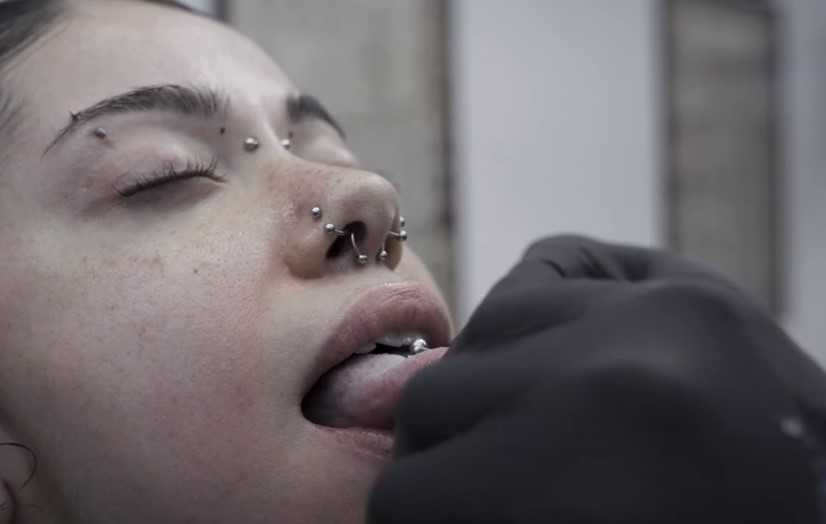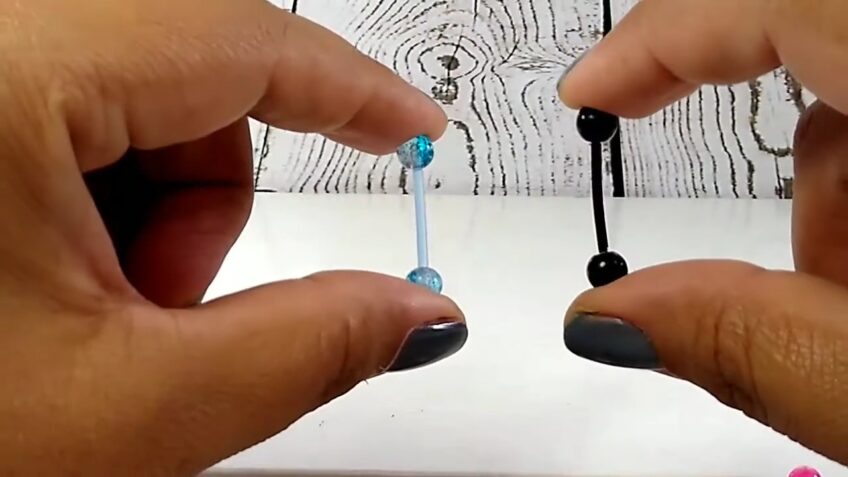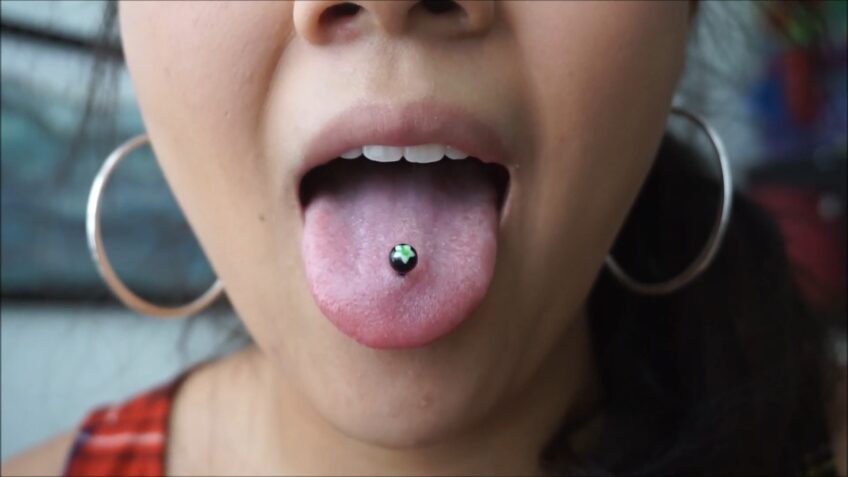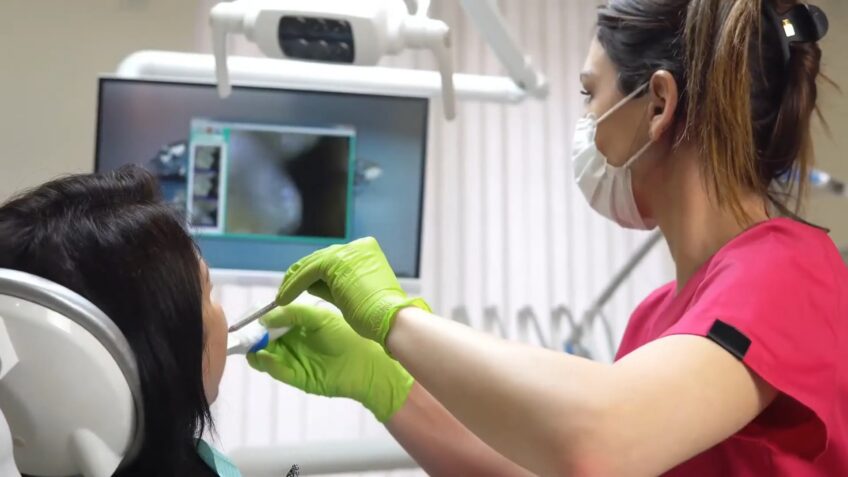Tongue piercings allow a fun way to express yourself, but the barbell can cause gum damage if proper care isn’t taken. Over time, excessive friction from the jewelry leads to gum recession around the piercing.
With good piercing technique, quality jewelry, and attentive aftercare, you can have a tongue piercing without significant gum damage. This requires understanding placement, sizing, hygiene, and checking for problems quickly.
Follow these tips to keep your tongue piercing secure and prevent gum recession.
Choosing a Reputable Piercer

Getting your tongue pierced by a qualified professional prevents unnecessary complications like gum damage. Research piercers specifically renowned for tongue piercings, not just trendy spots.
A great piercer will:
- Use sanitized tools and jewelry
- Have specialized piercing tools
- Avoid too-large starter jewelry
- Precisely pierce the ideal tongue location
Ask about their training, sanitation, and experience with tongue piercings. Reviews and portfolios can help identify piercers who emphasize client safety and comfort.
Proper Piercing Placement

Piercer skill is crucial to avoid hitting nerves, blood vessels or piercing too shallow, which can all increase gum damage. The best location is the center tip of the tongue, with the bottom ball safely behind teeth.
Avoid piercing placements that raise gum recession risks:
- Too far back on the tongue
- Pierced at an incorrect angle
- Too close to the tongue’s left or right edges
- Inserted too shallowly into the tongue muscle
Listen to guidance on proper placement and length for you. But speak up if suggestions seem too far back or angled, which lead to extra gum friction. A great piercer will have many years of experience and emphasize safety. Read more about how to identify quality piercing studios.
Choosing a Large Enough Barbell

Initially, the barbell must be long enough to accommodate significant swelling in the first 3-4 days. Standard starter barbell lengths are 16mm (5/8”), 18mm (3/4”) or 20mm (13/16”).
Too short of a barbell will become deeply imbedded as the tongue swells over the ends. This traps bacteria against the piercing hole, almost guaranteeing infection. It also causes excess friction against the gums.
A longer barbell allows the swelling to occur without pressing the ends painfully into the tongue or gums. Once the swelling subsidizes after a week or so, a shorter barbell can be inserted by your piercer.
Quality of the Jewelry

The composition, gauge, and finishes of the starter barbell are also important. Appropriate initial jewelry:
- Surgical steel or titanium bar, not plastics
- 14 or 16 gauge
- Polished, smooth finish without engravings
- Ball ends screwed on, not soldered or glued
A smooth, heavy barbell will weigh down the tongue away from the gums. Lightweight plastics have higher risk of migration or gum impingement. Any textured surfaces or engravings also increase irritation during healing.
Leave the starter barbell in place for at least 6-8 weeks before changing jewelry. This allows the fistula to fully stabilize. Making jewelry changes too early risks damaging the healing piercing.
In addition to quality jewelry, it’s important to get regularly tested for HPV if you have a tongue piercing. Make sure to visit your doctor and dentist regularly for checkups and mention you have a tongue piercing so they can examine your mouth closely. Getting tested and treated for HPV quickly is crucial for protecting your health.
Keeping the Barbell Clean
Once pierced, you must keep the barbell and piercing site very clean. Food, plaque, and bacteria easily accumulate around the barbell and must be removed.
After eating or drinking anything besides water, use an antibacterial alcohol-free mouthwash. Gently rinse for 60 seconds, allowing the solution to flow over the barbell. Repeat this 2-3 times daily at minimum.
Invest in a soft bristle toothbrush and use a gentle brushing motion around the barbell after rinsing. Take care not to tug the bristles over the barbell which can irritate the piercing site. Always brush your teeth before mouthwash to remove plaque.
You can also dissolve 1/8-1/4 tsp of salt into an 8 oz glass of warm water for an antibacterial saline solution. Swish this for 60 seconds over the piercing 1-2 times daily. Only use this in addition to regular mouthwash and brushing, not in place of.
Never use peroxide, alcohol, baking soda, or other harsh products. And avoid sharing drinks or kissing to prevent transfer of bacteria during healing.
Downsize the Barbell
As mentioned earlier, the initial long barbell should remain for a minimum of 6-8 weeks until the piercing is fully stabilized. After 2 months, the swelling will have resolved enough to downsize the barbell length.
See your original piercer for downsizing, or at least another APP certified professional. They can assess your piercing for depth, angle, and placement to determine the ideal shorter barbell length.
Inserting a barbell that is too short too soon will re-traumatize the healing piercing. But a properly sized shorter barbell helps limit excess barbell movement that could irritate your gums.
Never Try to Change It Yourself

It’s imperative that you never try to change or replace the barbell yourself during the healing period. Not only can you damage the fresh piercing, but improper self-insertion risks poor placement and angle of the new jewelry.
Always see an experienced piercer for any jewelry changes, especially downsizing. They know how to gently insert, remove, and replace piercing jewelry to avoid recession risks.
Daily Habits to Prevent Recession After Healing
Once your tongue piercing has stabilized after 8-12 weeks, you still need to be attentive. Poor habits can cause barbell migration or gum recession even in healed piercings. Be mindful to:
- Keep using antibacterial mouthwash daily
- Avoid chewing gum or tongue sucking habits
- Gently brush around the barbell, not over it
- Visit your dentist for regular cleanings and checkups
- Refrain from playing with the barbell using teeth or fingers
See your piercer immediately if you ever feel the barbell is shifting position or loosening. Migration must be addressed promptly to avoid recession. Also have your dentist evaluate any potential gum recession detected during cleanings.
In some cases, gum recession or dental issues may mean a tongue piercing isn’t viable for you. Be prepared to remove the piercing if recommended by your dentist for gum health.
Caring for Your Piercing Properly

With attentive aftercare and smart habits, it is possible to maintain your tongue piercing without significant gum recession. Be sure to:
- Choose an extremely qualified piercer
- Start with appropriate barbell length and gauge
- Use quality starter jewelry
- Adhere closely to cleaning and mouthwash routines
- Downsize the barbell only when ready
- See your piercer for any jewelry changes
- Monitor daily habits like chewing or playing with jewelry
- See your dentist regularly to check for problems
There are always some risks with any oral piercing. But you can greatly reduce your risk for complications like recession if you care for your new piercing properly. Be patient during the long healing process. And be vigilant even after healing to prevent issues from developing.
With a reputable piercer and attentive aftercare, you can feel confident showing off your new tongue jewelry without putting your beautiful smile and gum health in jeopardy.

